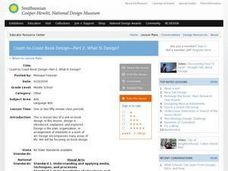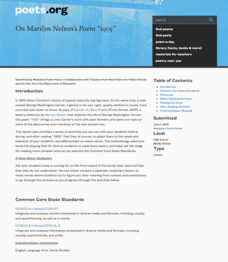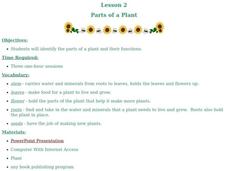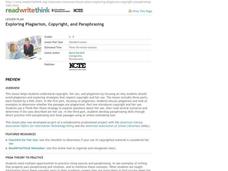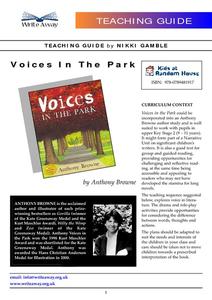Curated OER
Coast-to-Coast Book Design -Part 2: What is Design?
Students explore the concept of design, and identify items in their lives that have been designed. They explore the concept of book design and create and arrange their own page layout.
Curated OER
Scrolling Along
Young scholars summarize the important parts of a story, identify the characters, and decide how to picture several scenes that describe the setting and action. They graphically represent the important elements of the story on a fabric...
Curated OER
Lesson Plan 18: Cleaning It Up
Careful proofreading is an important step in the writing process. After guided practice using a provided worksheet that details common grammar concepts, young writers refer to the worksheet as they proofread their own work....
Curated OER
Related Lessons Animal
Students examine the extinction of dinosaurs. In this dinosaur lesson students create their own dinosaur eggs, get into groups and complete a diorama activity.
August House
Billy Brown and the Belly Button Beastie
How would you feel if you lost your belly button? Read about Billy Brown in Billy Brown and the Belly Button Beastie by Bobby and Sherry Norfolk. Young learners retell the story, answer questions, focus on the letter B and...
Scholastic
Lesson Three: The Earth, Movement in Space
If you feel like you're standing still, you're wrong! The Earth is constantly rotating and orbiting under our feet. Demonstrate the Earth's movement within the solar system with a collaborative activity. With a candle or lamp in the...
EngageNY
Drawing a Conclusion from an Experiment (part 1)
Challenge your classes to complete an experiment from beginning to end. Learners make their own hypotheses, collect and analyze their own data, and make their own conclusions. They are on their way to becoming statisticians!
Goethe-Institut
Well-Known Tale: The Pied Piper of Hamelin
"The Pied Piper of Hamelin" is the focus of a lesson plan designed to shed light on the importance of keeping promises. As a class, scholars take part in a discussion on the topic of honesty and consequences. Independent readers then...
Academy of American Poets
On Marilyn Nelson's Poem “1905”
Marilyn Nelson's poem, "1905," asks young scholars to compare and contrast George Washington Carver and Albert Einstein. After studying images of the two scientists and listing their observations, class members listen to several readings...
Curated OER
Writing a Book Review - Fiction
Fifth graders write a fiction book review. In this response to literature lesson, 5th graders read a story and share their understanding and opinion of the book. They write what the book is about, what they like about the book, and what...
Curated OER
Book Letters
Students study language. In this writing lesson, students listen to a story and then compose a friendly letter, about the book, to a friend. They work independently to compose their letter depicting what happened in the story,...
Curated OER
WOW - Who Or What? (A Six Trait Lesson)
Students locate and select riddles in library books to share, write riddles using template, select appropriate parts of speech to complete riddle template using AlphaSmart, correctly capitalize and punctuate riddle, and illustrate their...
Curated OER
Parts of a Plant
Students identify the parts of a plant and their functions. In this plant biology lesson plan, students view a PowerPoint presentation on plants and their parts and discuss the functions of each part. Students observe a real plant and...
Curated OER
Writing a Book Review - Non-Fiction
Fifth graders write a book review for a nonfiction book. For this response to literature lesson, 5th graders read a nonfiction book and write a review that gets others interested in reading the book without giving too much away. The...
Curated OER
Potter Book Review
Students describe the plot of the latest Harry Potter novel and comment on the highlights and weak points. They then evaluate the novel and understand the layout of a book review.
Curated OER
Action Verb Lesson
Second graders become familiar with action verbs through the reading of To Root, To Toot, to Parachute: What is a Verb? In this action word instructional activity, 2nd graders analyze sentences for the action verb. Students watch a...
Curated OER
Identifying Features of Nonfiction Text
Learners explore nonfiction text. They identify the cover, title page, and table of contents of a nonfiction book. Pupils work in groups to create a chapter for a nonfiction class book about heroes.
Curated OER
Mr. Lincoln's Whiskers
Young scholars compose a letter to a family member. In this writing activity, students listen to the book, Mr. Lincoln's Whiskers and identify the parts of a letter.
Curated OER
Edible and Medicinal Plants: Field Trip Guide
Though it's designed to guide a field trip to the New York Botanical Garden, you could take resource like this one to a local park, wilderness area, school garden, or even a weedy empty lot. Middle schoolers identify plant parts and...
ReadWriteThink
Exploring Plagiarism, Copyright, and Paraphrasing
Plagiarism, copyright, and fair use are the focus of a three-part instructional activity designed to inform scholars of how to properly cite others' work. First, pupils use a KWL chart to begin thinking and...
Write Away!
Voices In the Park
Explore the impact a narrator's point of view has on a story with a reading of the children's book, Voices in the Park by Anthony Browne. Written in four different voices, the story is told and retold from different perspectives to...
Jessica Winston
Tacky and the Winter Games
Helen Lester's wonderfully wacky, Tacky and the Winter Games, is the core text featured in a resource packet that includes a prediction exercise, an activity menu, vocabulary flash cards, and book review worksheet. A great way to cheer...
Scholastic
Tell Us a Tale: Teaching Students to Be Storytellers
Encourage scholars to retell their favorite short story or folktale, adding personal details to make it their own. After reading their book of choice several times, story tellers retell a tale verbally to their classmates.
Baylor College
How Much Water Do Humans Need?
Physical or life science learners measure the amounts of water eliminated by intestines and the urinary system, and the amounts lost via respiration and perspiration. In doing so, they discover that the body's water must be replenished...
